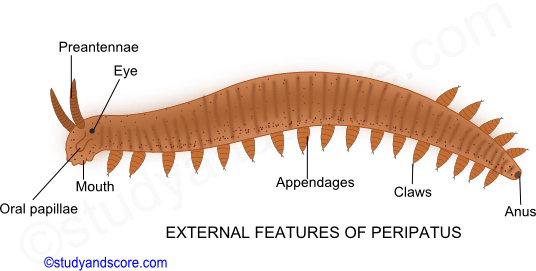Onychophora status Introduction
Onychophora is a Greek term, onyx=Claw and pherein=to bear which means claw bearing animals. Onychophora was conventionally classified as one of the classes of the phylum Arthopoda. But modern system of classification gives it a status of independent phylum. As there are only 70 species included in this phylum it is considered as a minor phylum.
The most familiar genus of this phylum is Peripatus. These are very interesting caterpillar like forms which display both annelidans as well as arthopodan characters besides its own typical features. Owing to its resemblance with the two phyla, peripatus is often referred to as the connecting link between Annelida and Arthopoda.
Peculiar anatomical features of Peripatus
- The body wall is dermo-muscular, consisting of cuticle, epidermis, dermis and striped circular and longitudinal muscles.
- Coelom is in the form of small cavities around the gonads and metanephridia.
- The body cavity is haemocoel, lined with epithelium.
- A pair of slime glands is located one on either side of the body cavity
- The mouth leads into alimentary canal which consists of tongue with rows of sensory spines, muscular pharynx, large salivary glands and short oesophagus, long mid gut or stomach-intestine and short hind gut or rectum.
- The respiratory organs are unbranched trachea communicating outside through spiracles.
- The excretory organs are coxal glands opening at the base of legs.
- Dorsal tubular contractile heart lies within pericardial cavity.
- The nervous system consists of brain with two circum-pharyngeal connectives and a pair of longitudinal nerve chord.
- Sensory organs are a pair of eyes near the base of antennae, taste spines on the lips, pre oral cavity and tactile spines on surface tubercles.
- Female reproductive system includes a pair of ovaries, a pair of oviducts and a pair of beaded uteri. Male reproductive system consists of a pair of testes, vas differentia, genital openings and seminal vesicles.
- Female produces about 30 or more young ones in a year. The young resemble the adults.
Affinities of Peripatus
Peripatus has no economic importance but zoologically it is very interesting because it possess the characters of both Annelida and Arthopoda as well as the peculiarities of its own.

Annelidan characteristics
- Vermiform body with truncated extremities
- Absence of true head
- Dermo-muscular body wall consisting of flexible cuticle with underlying circular an longitudinal muscles.
- Locomotion is slow and by peristalsis as in case of earthworm.
- Structure of eyes is simple as in case of polychaetes.
- Unjointed, hollow, stumpy appendages like the parapodia of polychaetes.
- Simple, straight alimentary canal with terminal mouth and anus.
- Segmentally arranged paired nephridia.
- Similar excretory glands
- Presence of cilia in excretory and reproductive ducts
Arthropodan characteristics
- Presence of antennae
- Jaws are modified appendages provided with striped muscles.
- Locomotion by definite legs with well-defined musculature and claws
- Cuticle with thin deposit of chitin like arthropods
- Body cavity is haemocoel
- Coelom is reduced to small cavities arranged around gonads and metabephridia
- Peculiar salivary glands
- Dorsal tubular heart
- Presence of tracheal respiratory system
- Large and typically arthropod like brain
- General structure of the reproductive organs resemble arthropods
Onychophoran characteristics
- Body shows no or indistinct external segmentation
- Texture of skin. Rough cuticle covered with numerous velvety processes not known in other phyla
- Antennae not homologous to the antennae of Arthropoda
- Three segmented head which is a condition midway between annelida and arthropoda
- Restriction of jaws to single pair.
- Irregular distribution of the spiracles of the tracheal openings
- Two ventral widely separated nerve chords and no true ganglia
- Structure of eyes is less complicated
- Distribution of reproductive organs.
Molluscan characteristics
Peripatus was previously included in the phylum Mollusca due to its slug-like appearance of body and ladder like nervous system. But these characters are only superficial resemblances.
Systemic position of the Phylum onychophora
Onychophora has the characters of both Phylum Annelida and Phylum Arthropoda. Therefore, they are regarded as the intermediate stage or the connecting link between Annelida and Arthropoda. However, they appear to be more closely allied to arthropods than to annelids and have arisen as an offshoot from the base of arthropod line.
Based on such phylogenetic considerations, Manton and many other Zoologists have included Onychiphorans as a class in Arthropoda. But, lack of exoskeleton, joined limbs and presence of annelidan characters in onychophora created a serious problem.
Many others claim that peripatus is definitely an annelid. In fact onychophorans are neither worms nor arthropods but have distinct characters of their own. Hence, Onychophora is now-a-days treated as a separate phylum.
It is undoubtedly a very ancient group because a mid-cambraian fossil, Aysheaia, closely resembles modern onychophora. Its extreme isolation and discontinuous distribution at present suggest that this group has lived through many geological ages and that it has been more wide spread and diversified in past. Aysheaia and Peripatus suggest that arthropoda may have evolved from annelid like ancestors.

- What is the most familiar genus of the phylum Onychophora?
- Give out the meaning of the term Onychophora.
- Mention Annelidan and Arthropodan characteristics of Peripatus.
- Discuss systematic position of Onychophora.
- Share with your friends! -


Login to post your comment here...
- or with social Account -